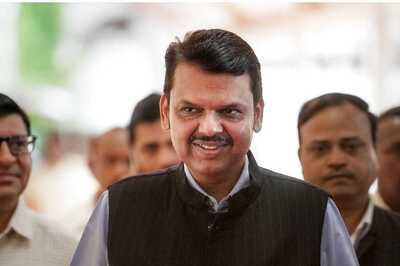
views
Mental health is a dreaded topic of discussion in a middle class Indian household. Considered a stigma, often mental health struggles are shrugged off as mood swings. However, the mental health statistics are staggering. According to the National Health Mission, 7 per cent of the population suffers from mental disorders. The WHO also notes that one in four families is likely to have at least one member with a behavioural or mental disorder.
While high threshold mental disorders like schizophrenia, autism and post-traumatic stress disorder (PTSD) are recognised and acknowledged in our society, the same cannot be said of low threshold disorders like anxiety, depression and grief. The National Family Health Survey-5 data reveals that one in three married women experience intimate partner violence, and of them, less than 90 per cent have never sought help. NIMHANS estimates that 14 per cent of such victims met the criteria for PTSD and all of them met the criteria for depression. The issue has been further accentuated by the pandemic, with a large percentage of Indians of all ages, all social and economic classes suffering from such disorders caused by gender-based violence, loneliness, stress and disease.
ALSO READ | Missing Females: COVID-19 Underreporting among Women Exposes a Persistent and Global Problem
The Stree Manoraksha Project, launched in NIMHANS a week before Women’s Day, is an initiative for improving women’s mental health, with a focus on victims of violence through establishment of OSC (One-Stop Center) functionaries. It will create mental health warriors trained in self-defence and how to handle the cases of violence among women. A dedicated effort to improve mental health started when the Mental Healthcare Act, 2017 was passed with the objective to provide mental healthcare services to persons with mental illness. Interventions and policy measures — such as the National Tele-Mental Health Programme announced in the Union Budget 2022 — definitely shine a light on the positive road ahead. These are important first steps that have started discussions at the highest levels on mental health, its socio-economic implications, and the need for a comprehensive mental health policy.
Cause and Effect
World Economic Forum (WEF) estimates that for low- and middle-income countries like India, the total economic cost of mental illnesses will exceed $2 trillion by 2030. The global shift towards ideas of sustainable development, multidimensional poverty and quality of life, is indicative of a broader conception of development, which seeks to incorporate the conception of mental health.
In social development, poorer mental health has been associated with poverty and social stratification. Depression among women, especially those in reproductive age, is consistently higher than men, further exacerbated by gender-based violence. Depression is also closely associated with lower literacy and nutrition, poor housing, and even urbanisation. At the microeconomic scale, poor mental health is associated with financial strain and debt. In the labour market, it is associated with low or reduced income and poor productivity. Similarly, burnout and depression are linked with falling employment levels and low reskilling and upskilling in the industry. In political development, mental health deterioration is associated with various forms of discrimination like race, caste and religion. It is also linked with political representation, crime rates, communal violence and human rights.
The most important finding is that there are several bi-directional causal links between mental health and social, economic and political development. WHO recommends policymakers to deinstitutionalise mental healthcare, integrate mental health into general healthcare, and develop community mental health services. Norway, Canada and Argentina have some of the best mental health policies globally. They place emphasis on mobilising and sensitising families and communities to be the first responders, and empower local governments to provide low threshold support services. This enables those seeking help, especially teenagers and young adults, to obtain support at an early stage. Special programmes are designed to be culturally conscious of different demographics and support minorities. Another feature is the identification of closely associated risks such as substance abuse and cyber harassment, and incorporating mental health-related reforms in policies on those issues.
Way to a Mentally Healthy New India
In India, the National Tele-Mental Health programme will include a network of 23 tele-mental health centres of excellence, with NIMHANS being the nodal centre and International Institute of Information Technology, Bangalore providing technology support. This integration of mental health and digital infrastructure will bridge the existing gap amongst different stakeholders. The focus on tele-counselling, which makes it open to digital interventions, will improve the privacy aspect, thereby addressing the aspect of ‘stigma’ that is prevalent towards mental health. For its widespread implementation, it is equally important to support the industry by removing GST from all mental healthcare services, directing insurance firms to bring mental health into mainstream health coverage, and setting up premier mental health-focused academic institutions and hospitals.
ALSO READ | Look Beyond AIIMS and NIMHANS to Start a Mental Health Revolution in India
As the next step, there should be an effort to integrate and create an umbrella structure around mental health perspectives for formulation of policies on key social and economic issues. Segment-focused programmes like the Stree Manoraksha project for school and undergraduate students, young professionals and the elderly are needed. Unemployment and labour laws should offer mental health support. Secondary education, higher education and upskilling programmes should encourage mental self-care and provide training to faculty to act as first responders. Lastly, awareness campaigns should be implemented through local government and community bodies to destigmatise the narrative around mental illnesses.
These are just the initial steps and we’re certain that with reforms like these, we’re on the right path to create a mentally and emotionally healthy society. As individuals, we should practise mental self-care and support our loved ones in doing the same. This is the way. The way to a mentally healthy New India.
Siddhey Shinde is Young Professional, Science and Technology Vertical, NITI Aayog. Juhi Jain is Young Professional, Atal Innovation Mission, NITI Aayog. The views expressed in this article are those of the authors and do not represent the stand of this publication.
Read all the Latest Opinion News and Breaking News here




















Comments
0 comment